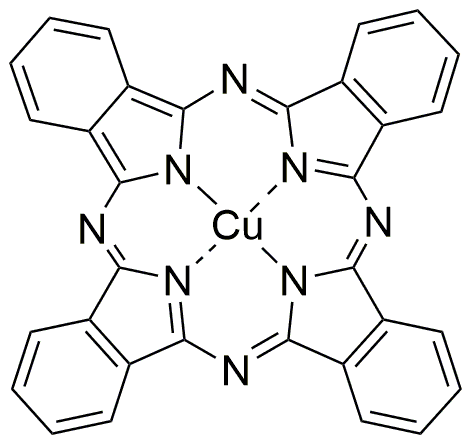Copper(II) phthalocyanine (a-form) is widely utilized in research focused on:
- Dyes and Pigments: This compound is a key ingredient in the production of high-performance blue and green pigments used in paints, plastics, and textiles, providing excellent color stability and lightfastness.
- Electronics: It serves as a vital component in organic semiconductors, enhancing the performance of electronic devices such as solar cells and organic light-emitting diodes (OLEDs), which are known for their energy efficiency.
- Photodynamic Therapy: In the medical field, it is used in photodynamic therapy for cancer treatment, where it acts as a photosensitizer, helping to selectively destroy cancer cells when exposed to light.
- Antimicrobial Coatings: The compound is incorporated into coatings for surfaces to provide antimicrobial properties, making it valuable in healthcare settings to reduce the spread of infections.
- Research and Development: It is widely studied in materials science for developing new materials with unique optical and electronic properties, paving the way for innovations in various technologies.
General Information
Properties
Safety and Regulations
Applications
Copper(II) phthalocyanine (a-form) is widely utilized in research focused on:
- Dyes and Pigments: This compound is a key ingredient in the production of high-performance blue and green pigments used in paints, plastics, and textiles, providing excellent color stability and lightfastness.
- Electronics: It serves as a vital component in organic semiconductors, enhancing the performance of electronic devices such as solar cells and organic light-emitting diodes (OLEDs), which are known for their energy efficiency.
- Photodynamic Therapy: In the medical field, it is used in photodynamic therapy for cancer treatment, where it acts as a photosensitizer, helping to selectively destroy cancer cells when exposed to light.
- Antimicrobial Coatings: The compound is incorporated into coatings for surfaces to provide antimicrobial properties, making it valuable in healthcare settings to reduce the spread of infections.
- Research and Development: It is widely studied in materials science for developing new materials with unique optical and electronic properties, paving the way for innovations in various technologies.
Documents
Safety Data Sheets (SDS)
The SDS provides comprehensive safety information on handling, storage, and disposal of the product.
Product Specification (PS)
The PS provides a comprehensive breakdown of the product’s properties, including chemical composition, physical state, purity, and storage requirements. It also details acceptable quality ranges and the product's intended applications.
Certificates of Analysis (COA)
Search for Certificates of Analysis (COA) by entering the products Lot Number. Lot and Batch Numbers can be found on a product’s label following the words ‘Lot’ or ‘Batch’.
Numéro de catalogue
Numéro de lot/série
Certificates Of Origin (COO)
This COO confirms the country where the product was manufactured, and also details the materials and components used in it and whether it is derived from natural, synthetic, or other specific sources. This certificate may be required for customs, trade, and regulatory compliance.
Numéro de catalogue
Numéro de lot/série
Safety Data Sheets (SDS)
The SDS provides comprehensive safety information on handling, storage, and disposal of the product.
DownloadProduct Specification (PS)
The PS provides a comprehensive breakdown of the product’s properties, including chemical composition, physical state, purity, and storage requirements. It also details acceptable quality ranges and the product's intended applications.
DownloadCertificates of Analysis (COA)
Search for Certificates of Analysis (COA) by entering the products Lot Number. Lot and Batch Numbers can be found on a product’s label following the words ‘Lot’ or ‘Batch’.
Numéro de catalogue
Numéro de lot/série
Certificates Of Origin (COO)
This COO confirms the country where the product was manufactured, and also details the materials and components used in it and whether it is derived from natural, synthetic, or other specific sources. This certificate may be required for customs, trade, and regulatory compliance.


